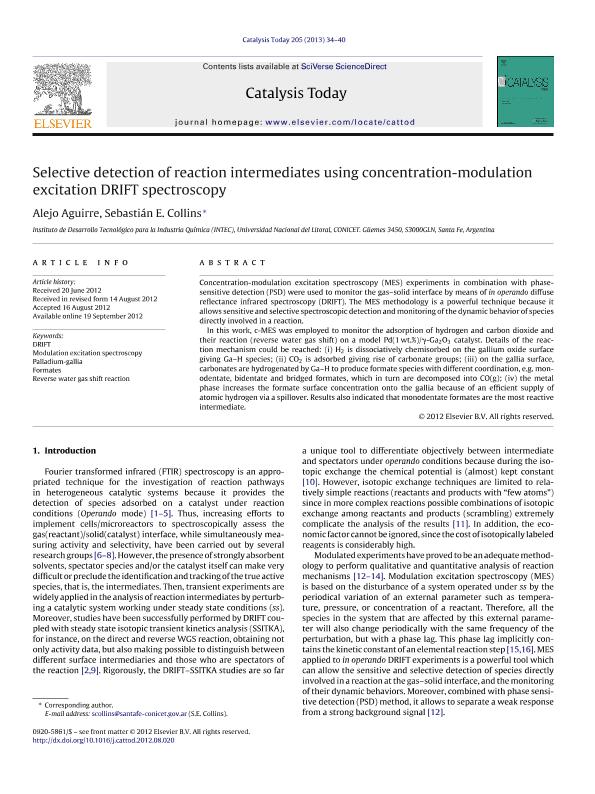Mostrar el registro sencillo del ítem
dc.contributor.author
Aguirre, Alejo

dc.contributor.author
Collins, Sebastián Enrique

dc.date.available
2015-09-10T14:23:43Z
dc.date.issued
2013-04-30
dc.identifier.citation
Aguirre, Alejo; Collins, Sebastián Enrique; Selective detection of reaction intermediates using concentration-modulation excitation DRIFT spectroscopy; Elsevier Science; Catalysis Today; 205; 30-4-2013; 34-40
dc.identifier.issn
0920-5861
dc.identifier.uri
http://hdl.handle.net/11336/1988
dc.description.abstract
Concentration-modulation excitation spectroscopy (MES) experiments in combination with phase-sensitive detection (PSD) were used to monitor the gas–solid interface by means of in operando diffuse reflectance infrared spectroscopy (DRIFT). The MES methodology is a powerful technique because it allows sensitive and selective spectroscopic detection and monitoring of the dynamic behavior of species directly involved in a reaction. In this work, c-MES was employed to monitor the adsorption of hydrogen and carbon dioxide and their reaction (reverse water gas shift) on a model Pd(1 wt.%)/γ-Ga2O3catalyst. Details of the reaction mechanism could be reached: (i) H2 is dissociatively chemisorbed on the gallium oxide surface giving Ga–H species; (ii) CO2 is adsorbed giving rise of carbonate groups; (iii) on the gallia surface, carbonates are hydrogenated by Ga–H to produce formate species with different coordination, e.g. monodentate, bidentate and bridged formates, which in turn are decomposed into CO(g); (iv) the metal phase increases the formate surface concentration onto the gallia because of an efficient supply of atomic hydrogen via a spillover. Results also indicated that monodentate formates are the most reactive intermediate.
dc.format
application/pdf
dc.language.iso
eng
dc.publisher
Elsevier Science

dc.relation
4th International Congress on Operando Spectroscopy
dc.rights
info:eu-repo/semantics/openAccess
dc.rights.uri
https://creativecommons.org/licenses/by-nc-sa/2.5/ar/
dc.subject
DRIFT
dc.subject
FORMATES
dc.subject
MODULATION EXCITATION SPECTROSCOPY
dc.subject
PALLADIUM-GALLIA
dc.subject
REVERSE WATER GAS SHIFT REACTION
dc.subject.classification
Ingeniería de Procesos Químicos

dc.subject.classification
Ingeniería Química

dc.subject.classification
INGENIERÍAS Y TECNOLOGÍAS

dc.title
Selective detection of reaction intermediates using concentration-modulation excitation DRIFT spectroscopy
dc.type
info:eu-repo/semantics/article
dc.type
info:ar-repo/semantics/artículo
dc.type
info:eu-repo/semantics/publishedVersion
dc.date.updated
2016-03-30 10:35:44.97925-03
dc.journal.volume
205
dc.journal.pagination
34-40
dc.journal.pais
Países Bajos

dc.journal.ciudad
Amsterdam
dc.description.fil
Fil: Aguirre, Alejo. Consejo Nacional de Investigaciones Científicas y Técnicas. Centro Científico Tecnológico Conicet - Santa Fe. Instituto de Desarrollo Tecnológico para la Industria Química. Universidad Nacional del Litoral. Instituto de Desarrollo Tecnológico para la Industria Química; Argentina
dc.description.fil
Fil: Collins, Sebastián Enrique. Consejo Nacional de Investigaciones Científicas y Técnicas. Centro Científico Tecnológico Conicet - Santa Fe. Instituto de Desarrollo Tecnológico para la Industria Química. Universidad Nacional del Litoral. Instituto de Desarrollo Tecnológico para la Industria Química; Argentina
dc.journal.title
Catalysis Today

dc.relation.alternativeid
info:eu-repo/semantics/altIdentifier/url/http://www.sciencedirect.com/science/article/pii/S0920586112005895
dc.relation.alternativeid
info:eu-repo/semantics/altIdentifier/doi/http://dx.doi.org/10.1016/j.cattod.2012.08.020
Archivos asociados
